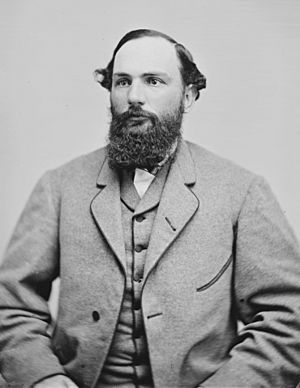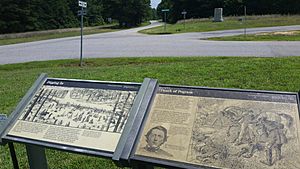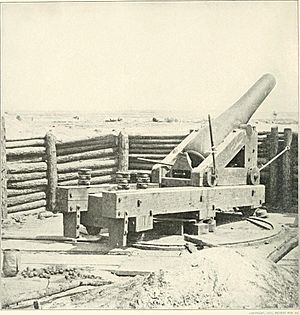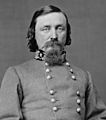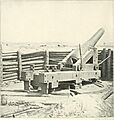Battle of Five Forks facts for kids
Quick facts for kids Battle of Five Forks |
|||||||
|---|---|---|---|---|---|---|---|
| Part of the American Civil War | |||||||
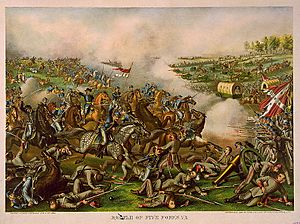 Sheridan's charge at Five Forks (lithograph published c.1886) |
|||||||
|
|||||||
| Belligerents | |||||||
| Commanders and leaders | |||||||
| Philip Sheridan Gouverneur K. Warren |
George Pickett | ||||||
| Units involved | |||||||
| V Corps | Units from Army of Northern Virginia | ||||||
| Strength | |||||||
| 22,000 | 10,600 | ||||||
| Casualties and losses | |||||||
| 830 | 2,950 | ||||||
The Battle of Five Forks was a very important battle fought on April 1, 1865. It took place southwest of Petersburg, Virginia, near a road junction called Five Forks. This battle happened at the very end of the Siege of Petersburg, which was a long period of fighting during the American Civil War.
In this battle, the Union Army, led by Major General Philip Sheridan, defeated a Confederate force. The Confederate soldiers were part of the Army of Northern Virginia and were commanded by Major General George Pickett. The Union forces caused over 1,000 Confederate soldiers to be killed or wounded. They also captured as many as 4,000 prisoners. By winning, the Union Army took control of Five Forks. This was a big deal because Five Forks was key to controlling the South Side Railroad. This railroad was a super important supply line and escape route for the Confederates.
After a smaller fight called the Battle of Dinwiddie Court House on March 31, Union soldiers arrived to help Sheridan's cavalry. General Robert E. Lee, the Confederate commander, had told Pickett to defend Five Forks "at all hazards." This meant it was extremely important to hold that spot.
Around 1:00 PM, Sheridan's troops kept the Confederate front line busy with gunfire. Meanwhile, a large group of Union infantry, led by Major General Gouverneur K. Warren, attacked the Confederate left side. Because of a strange sound effect in the woods, Pickett and his cavalry commander, Major General Fitzhugh Lee, didn't hear the battle starting. Their officers couldn't find them. Even though the Union infantry didn't know exactly where to attack, they managed to break the Confederate line. Sheridan himself helped encourage his soldiers. After the battle, Sheridan removed Warren from his command, which was a controversial decision. The Union Army held Five Forks, which meant General Lee had to leave Petersburg and Richmond. This started his final retreat, leading to the end of the war.
Contents
- Background
- Start of the Appomattox Campaign
- Opposing Forces
- The Battle of Five Forks
- Union Reinforcements Arrive
- Pickett Retreats to Five Forks
- Confederate Troop Placement
- Union Forces Prepare to Attack
- Grant Gives Sheridan Authority
- Sheridan's Attack Plan
- Confederate Commanders Absent
- The V Corps Attacks
- Warren Searches for Divisions
- Griffin Joins the Main Attack
- Pickett Returns to the Battle
- Union Cavalry Attack
- Five Forks is Captured
- Warren Leads a Final Charge
- Casualties
- Aftermath
- Images for kids
- See also
Background
The Long Siege of Petersburg
The Siege of Petersburg was a very long fight that lasted 292 days. It began in June 1864 when Union forces tried to capture Petersburg, Virginia. Petersburg was a vital city because it had important railroads and supply routes for the Confederate capital, Richmond. The Union Army, led by General Ulysses S. Grant, couldn't take the city right away. So, they settled into a long period of trench warfare.
The Union strategy was to wear down the smaller Confederate Army. They wanted to cut off all supplies and extend the Confederate defensive lines. The Confederates, even though they had fewer soldiers, were good at defending their trenches. They held out for over nine months.
By early 1865, General Lee knew his army couldn't defend Petersburg and Richmond much longer. He had very few extra soldiers. Lee thought the best chance was to leave Petersburg and Richmond. He hoped to get food and supplies and then join up with another Confederate force in North Carolina. If they could quickly defeat the Union army there, they might be able to fight Grant again.
Lee tried one last big attack on March 25, 1865, at Fort Stedman. This attack was meant to break the Union lines or make Grant shorten his army's positions. The Confederates captured the fort at first, but the Union soldiers quickly fought back. The Union Army took back the fort and caused about 4,000 Confederate casualties. This was a huge loss for the Confederates, who already had too few soldiers.
After this defeat, Lee knew that Grant would soon attack the last Confederate supply lines. These were the South Side Railroad and the Boydton Plank Road. If these were cut, the Confederates would have no way to get supplies or escape from Petersburg and Richmond.
Start of the Appomattox Campaign
Grant's Big Plan
Even before the Confederate attack on Fort Stedman, General Grant had already planned a major attack for March 29, 1865. His goals were clear: force the Confederates into a big battle where they could be defeated. If the Confederates stayed in their trenches, Grant wanted to cut off their last supply and communication routes. The Fort Stedman battle didn't change Grant's plans because the Union Army didn't lose any ground and their losses were small.
Grant ordered parts of his army to move west. Major General Andrew A. Humphreys's II Corps and Major General Gouverneur K. Warren's V Corps were to move. Also, Major General Philip Sheridan's cavalry, called the Army of the Shenandoah, would join them. Sheridan's cavalry had about 9,000 men. Grant wanted to cut off the Confederate supply lines.
Lee's Response
General Robert E. Lee was already worried about his army's ability to defend Petersburg. He knew Grant would attack his right side and try to cut his supply routes. On March 29, Lee sent about 10,600 soldiers, including infantry, cavalry, and artillery. This force was led by Major General George Pickett and Major General Fitzhugh Lee. Their job was to protect the important road junction at Five Forks. This spot was key because a Union force there could cut off the remaining Confederate roads and railroads.
Union Troops Move Forward
Before dawn on March 29, Warren's V Corps moved west of the battle lines. Sheridan's cavalry took a longer route south toward Dinwiddie Court House. Union forces were now in a strong position to attack the Confederate right side and the crucial Five Forks junction.
Skirmishes Before the Main Battle
There were a few smaller fights as the Union forces advanced. At the Battle of Lewis's Farm, Union soldiers pushed back Confederate brigades. Both sides had similar numbers of casualties. After this, Union forces occupied important road junctions, getting closer to the Confederate lines.
Then came the Battle of White Oak Road on March 31. General Lee saw an exposed part of the Union line and ordered an attack. In this fight, Union divisions were pushed back at first. However, Union reinforcements arrived and eventually drove the Confederates back. This battle cut off direct communication between the main Confederate line and Pickett's force at Five Forks. This was a big problem for the Confederates.
Battle of Dinwiddie Court House
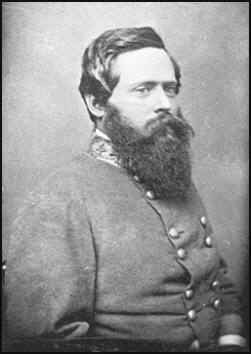
On March 29, Major General Philip Sheridan led his cavalry into Dinwiddie Court House. This was about four miles west of the Confederate lines and six miles south of Five Forks. Sheridan planned to take Five Forks the next day.
On March 30, in heavy rain, Sheridan's patrols found Confederate cavalry. That night, Major General George Pickett arrived at Five Forks with about 6,000 infantrymen. He took overall command of the Confederate forces there.
The rain continued on March 31. Pickett's forces attacked the Union cavalry. The Union soldiers fought hard, using their repeating carbines. They were forced to slowly retreat toward Dinwiddie Court House. Union brigades fought delaying actions, holding off the Confederates for hours. Eventually, Union Major General George Armstrong Custer set up a strong defensive line. This line, along with other Union brigades, held off Pickett's attack until darkness ended the battle. The Confederates planned to attack again in the morning.
The Confederates lost about 760 men killed and wounded in this fight. The Union lost 354 men. Pickett's brigade commander, Brigadier General William R. Terry, was injured.
Opposing Forces
Union
Confederate
The Battle of Five Forks
Union Reinforcements Arrive
On the evening of March 31, Union V Corps commander, Major General Gouverneur K. Warren, realized Sheridan's cavalry was being pushed back. He sent troops to help. Warren's soldiers had to deal with dark, muddy roads and a broken bridge. This caused delays.
General Grant told Sheridan that Warren's V Corps and another division were coming to help. Grant mistakenly said Warren would arrive by midnight, which was impossible. This misunderstanding later caused problems between Sheridan and Warren. When the Union reinforcements arrived, Pickett decided to pull his Confederate forces back to Five Forks.
Pickett Retreats to Five Forks
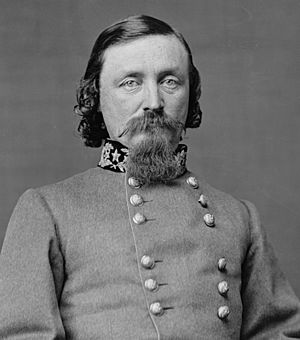
Around 10:00 PM, when Pickett learned Union infantry was arriving, he pulled his men back to their defensive lines at Five Forks. This retreat happened between 2:00 AM and 5:00 AM on April 1.
Pickett believed the Union forces would attack his left side. He reportedly sent a message to General Robert E. Lee asking for help. He also said he would have moved his troops further north if he hadn't received a message from Lee. This message, according to many historians, told Pickett to "Hold Five Forks at all hazards." This meant it was absolutely vital to defend the area. Lee knew that if the Union took Five Forks, they could cut off all major supply and escape routes for Petersburg and Richmond.
When the Confederates reached Five Forks, they tried to improve their trenches. However, the location of their lines wasn't the best, and some parts were in low areas.
Confederate Troop Placement
The Confederate line at Five Forks was made of thin pine logs and a shallow ditch. Pickett's placement of his troops was not good. His cavalry was in wooded, wet areas, making it hard for them to move. The artillery was also poorly placed. Confederate officers later said they didn't expect to face Union infantry, only cavalry. They thought they would be supported by more troops if infantry did show up.
Pickett's line stretched about 1.75 miles across Five Forks. He placed his cavalry on the right side. On the left, a small cavalry unit was supposed to cover a four-mile gap between Pickett's line and the main Confederate defenses.
Union Forces Prepare to Attack
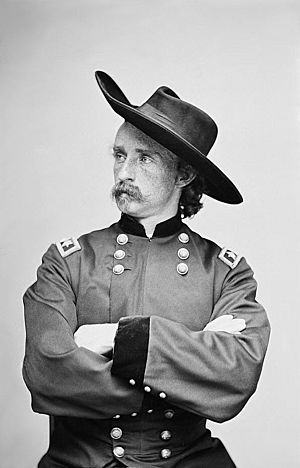
At dawn on April 1, Union scouts reported that the Confederates had pulled back. Sheridan quickly planned to attack Five Forks. He ordered his cavalry to pursue Pickett's force.
Union cavalry moved forward, with some dismounted to fight on foot. They found the Confederate defensive line but couldn't find a weak spot. Other Union cavalry divisions also moved into position, skirmishing with Confederate forces.
Grant Gives Sheridan Authority
Just before noon, General Grant sent a message to Sheridan. He told Sheridan that if he thought the V Corps would fight better under a different commander, he could remove General Warren from command. Sheridan hoped he wouldn't have to do this.
Sheridan's Attack Plan

Sheridan planned a strong attack. Custer's cavalry would make a fake attack on the Confederate right side. Warren's infantry corps would attack the left side. Other cavalry units would make a frontal attack when Warren's attack began.
Sheridan sent an officer to guide Warren's V Corps into position. The V Corps, with about 12,000 men, would attack in a wide front. The ground was rough and wooded, making it hard to see the Confederate defenses.
Confederate Commanders Absent
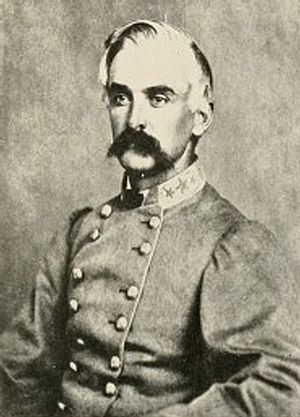
While the Union forces were getting ready, Confederate Major General Fitzhugh Lee and General Pickett were away from the front lines. They had gone to a "shad bake" lunch about 1.25 miles north of the battle.
Around 2:00 PM, a Confederate officer reported that Union cavalry had overpowered a Confederate brigade to the east. This meant Pickett's force was cut off from the main Confederate army. Fitzhugh Lee asked the officer to check again. He then saw Lee and Pickett riding away from the front.
After Pickett and Fitzhugh Lee left, Major General Rooney Lee was the highest-ranking officer, but he was on the far right of the line and didn't know he was in charge. Colonel Munford, who was closer to the action, saw the Union attack forming. He sent several messengers to find Pickett or Fitzhugh Lee, but they couldn't be found. The Confederate unit commanders had to prepare for the attack on their own.
The V Corps Attacks
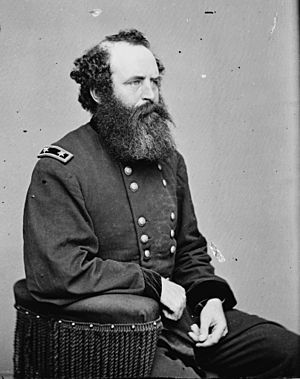
Around 4:15 PM, the Union attack began. Sheridan, Warren, and other officers rode at the front of Brigadier General Romeyn B. Ayres's division. Union skirmishers pushed back the Confederate outposts.
As Ayres's men crossed White Oak Road, they ran into Confederate fire. This showed that the Confederate line was further west than expected. This bad information meant two of the three Union divisions were past the end of the Confederate line, but in a good position to attack from the rear.
Ayres quickly realized the situation and turned his division to face the Confederate line. His men briefly hesitated under heavy fire. Sheridan rode along the line, shouting encouragement. He inspired the soldiers to move forward again. Some Confederate defenders broke and ran. Ayres's men captured over 1,000 prisoners and eight battle flags. However, the Union also suffered casualties, including two brigade commanders.
Warren Searches for Divisions

When two of Warren's divisions, Crawford's and Griffin's, went off course, Warren sent officers to find them. Warren set up a command post where he thought he could control the battle. Sheridan, however, believed Warren should have been leading from the very front.
Crawford's division had missed the end of the Confederate line entirely. Warren found one of Crawford's brigades and told them to change direction. He couldn't find Crawford himself.
Griffin Joins the Main Attack

Warren finally found Griffin's division, which had gone even further past the Confederate line. Griffin realized something was wrong when he didn't hit any fortifications. He saw the Confederate left flank and turned his men to attack it. Griffin's men, including Brigadier General Joshua Chamberlain's brigade, charged a new Confederate defensive line. After about half an hour of fierce fighting, Griffin's men broke this line, capturing about 1,500 prisoners.
Pickett Returns to the Battle
During their lunch, Pickett and Fitzhugh Lee heard gunfire and saw Union soldiers. They realized the battle was happening. Pickett rode back to the front, barely escaping capture. Fitzhugh Lee couldn't cross the road because Union soldiers had taken it.
Pickett found his officers trying to form a new line. He pulled more troops to create a third line of defense. Union brigades faced heavy fire but kept advancing. This third line also broke, and Union soldiers captured many prisoners and cannons.
Union Cavalry Attack
Union cavalry, led by Devin and Custer, dismounted and charged the Confederate defenses. They were ordered to leave one brigade mounted to exploit any breakthrough. Devin's men and part of Custer's division attacked the fortifications.
Custer tried to flank the Confederate right, but Rooney Lee's cavalry counterattacked. Lee's troopers held their ground, preventing Custer from getting behind the Confederate line. This allowed many Confederates to escape.
Five Forks is Captured
The remaining Confederate guns and part of a brigade still held the Five Forks intersection. Colonel Willie Pegram, a Confederate artillery officer, was mortally wounded while directing his cannons.
Union troops from Griffin's division arrived, adding pressure to the Union cavalry's attack. The Union cavalry charged over the fortifications. Devin then sent mounted cavalry after the fleeing Confederates. The Union cavalry captured almost 1,000 prisoners and seized two battle flags and two cannons.
After the Union cavalry broke the front line, Griffin's and Ayres's infantry divisions arrived. The Union battle line then moved west of the junction, securing the victory.
Warren Leads a Final Charge
Warren found Crawford's division hesitating. He took the corps flag and rode into the field, calling for his men to follow. The soldiers then attacked the Confederate line, capturing many prisoners. In this attack, Warren's horse was shot from under him.
After the Confederate line broke, Crawford's men moved west. Warren halted the pursuit as darkness fell and no more Confederates were in sight.
Casualties
The Battle of Five Forks was a costly fight. The Confederates lost about 600 killed and wounded, and 4,500 were taken prisoner. They also lost thirteen flags and six cannons. The Union Army had about 830 casualties, with 103 killed, 670 wounded, and 57 missing.
Aftermath
Confederate Survivors Retreat
The Confederate soldiers who survived the battle moved north through the woods. They crossed Hatcher's Run and headed toward the South Side Railroad. General Pickett tried to reorganize his scattered troops. He planned to cross the Appomattox River and rejoin the main Confederate Army.
Sheridan Removes Warren from Command
After the battle, around 7:00 PM, Sheridan sent a message to Warren. It said: "Major-General Warren, commanding Fifth Army Corps, is relieved of duty." Warren was told to report to General Grant. Sheridan believed Warren had not put enough effort into getting his troops ready for the attack. He also thought Warren didn't inspire enough confidence in his soldiers.
A surprised Warren rode to Sheridan's command post to ask him to change his mind. Sheridan refused, saying, "Reconsider? Hell! I don't reconsider my determination. Obey the order." Many of Warren's officers and men were shocked and felt Sheridan's action was unfair. Later, a military inquiry in 1883 found that Sheridan's removal of Warren was not justified.
Grant Orders a General Attack
Colonel Horace Porter, one of Grant's staff officers, excitedly reported the victory at Five Forks to Grant. He said over 5,000 prisoners were taken. This victory was huge because it opened the way for Union troops to reach the South Side Railroad.
As soon as Grant heard the news, around 8:00 PM, he ordered a general attack along the Petersburg lines. He wanted to prevent the Confederates from escaping. Union artillery began firing on the Confederate lines and continued for hours. The Confederates did not leave their positions, and the main Union assault began early the next morning.
Grant even sent a reporter to deliver the news and captured battle flags to President Lincoln. Lincoln was thrilled, saying, "Here is something material – something I can see, feel and understand. This means victory. This is victory."
Lee Learns of Defeat
After the battle, Fitzhugh Lee informed Robert E. Lee of the defeat at Five Forks. Lee then sent more troops to help Pickett reorganize and try to hold the South Side Railroad. Lee's goal was to defend Sutherland's Station, another important point on the railroad.
On April 2, Union attacks broke through the Confederate lines at the Third Battle of Petersburg. This forced the Confederate Army of Northern Virginia to flee toward Appomattox Court House. They surrendered there on April 9, 1865, effectively ending the Civil War.
Medal of Honor Recipients
Many Union Army soldiers received the Medal of Honor for their brave actions during the Battle of Five Forks. These included Wilmon W. Blackmar, John Wallace Scott, Robert F. Shipley, Thomas J. Murphy, August Kauss, William Henry Harrison Benyaurd, Jacob Koogle, George J. Shopp, Joseph Stewart, William W. Winegar, Albert E. Fernald, Adelbert Everson, James G. Grindlay, Charles N. Gardner, Henry G. Bonebrake, Hiram H. De Lavie and David Edwards.
Images for kids
-
Major General Fitzhugh Lee
-
Major General George Pickett
-
Brigadier General (Brevet Major General) George Armstrong Custer
-
Major General Philip Sheridan
-
Colonel Thomas T. Munford
-
Brigadier General Romeyn B. Ayres
-
Major General Gouverneur K. Warren
-
Brigadier General Charles Griffin
See also
 In Spanish: Batalla de Five Forks para niños
In Spanish: Batalla de Five Forks para niños



